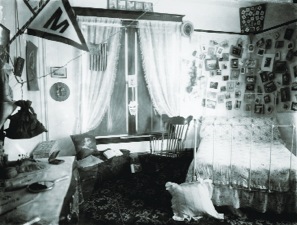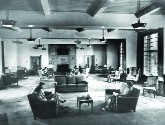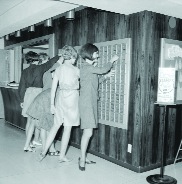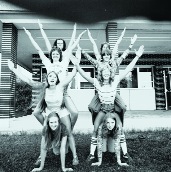Artifacts
by Betsy Holmquist
Photos from top, clockwise, AVii, 5-9, corbin Hall, Cherry Pie Contest, Cheerleading Camp, 67-150-2, Theta sigs, courtesy of the K. Ross Toole Archives, UM
Dear old golden rule days
 As early as 1895 UM adopted the role of in loco parentis over its female students. Girls as young as thirteen attended the University, living in “town houses” until the first women’s dorm opened in 1902. As the years passed, so did the rules and mores governing UM’s females. Let’s revisit some of those days.
As early as 1895 UM adopted the role of in loco parentis over its female students. Girls as young as thirteen attended the University, living in “town houses” until the first women’s dorm opened in 1902. As the years passed, so did the rules and mores governing UM’s females. Let’s revisit some of those days.
At the turn of the nineteenth century, “young ladies of the basket ball team” are not allowed to play public games, have a male coach, or be present in the gym when men are there.
A May 1913 Montana Kaimin article examines the perils of a girl being caught enjoying a “spread” (picnic) in her dorm room after hours (9:00 p.m.) and sneaking out a window to meet a gentleman for a weeknight movie.
By-laws in the 1919 women’s handbook even regulate women living off campus: “No woman in the university shall occupy a room in a house where men are located except by special permission from the dean of women.”
 The 1936 Handbook for Freshman Women reminds smoking coeds to use the ashtrays, but that “the copper, silver, and gold ash trays are ornamental.” Further cautions include not to smoke while dancing nor chew gum at a formal affair. “If you take a blind date,” the handbook reminds them, “remember that perhaps the man may not like your type either . . . be your gayest. Only boring people are bored.”
The 1936 Handbook for Freshman Women reminds smoking coeds to use the ashtrays, but that “the copper, silver, and gold ash trays are ornamental.” Further cautions include not to smoke while dancing nor chew gum at a formal affair. “If you take a blind date,” the handbook reminds them, “remember that perhaps the man may not like your type either . . . be your gayest. Only boring people are bored.”
 The 1945 Kaimin editor discusses “that perennial problem of women’s dormitory hours.”
The 1945 Kaimin editor discusses “that perennial problem of women’s dormitory hours.”
The 1946 handbook for women students stipulates their dress code: skirts, sweaters, blouses, simple wool or cotton dresses for class. No slacks. Galoshes for football games and suits or tailored dresses for most social events. Purse and gloves for teas and receptions.
 An editorial in a 1963 Kaimin argues against campus double standards, including cigarette machines in the men’s dorms but not the women’s; male students being allowed to wear Bermuda shorts to class while women are required to wear dresses; and the no-hours policy in the men’s dorms versus women’s hours—10:30 p.m. weekdays and 1:00 a.m. on weekends.
An editorial in a 1963 Kaimin argues against campus double standards, including cigarette machines in the men’s dorms but not the women’s; male students being allowed to wear Bermuda shorts to class while women are required to wear dresses; and the no-hours policy in the men’s dorms versus women’s hours—10:30 p.m. weekdays and 1:00 a.m. on weekends.
In 1968 male residents go to bat for the females, presenting an “Open Dorm” policy to President Pantzer asking that “escorted women” be allowed into the living and social areas of men’s dorms for a few hours on Friday and Saturday nights and Sunday afternoons.
 Fall 1968—Brantly Hall offers “no-hours” privileges to its upper-class women residents. Aber Hall opens as the first male/female dorm with sexes separated by floors.
Fall 1968—Brantly Hall offers “no-hours” privileges to its upper-class women residents. Aber Hall opens as the first male/female dorm with sexes separated by floors.
 Today all but two dorms on campus are coed. Griz cards allow students twenty-four hour access to dorms. Students can't burn candles or smoke, but they can drink in their dorm rooms if all present are twenty-one years of age.
Today all but two dorms on campus are coed. Griz cards allow students twenty-four hour access to dorms. Students can't burn candles or smoke, but they can drink in their dorm rooms if all present are twenty-one years of age.